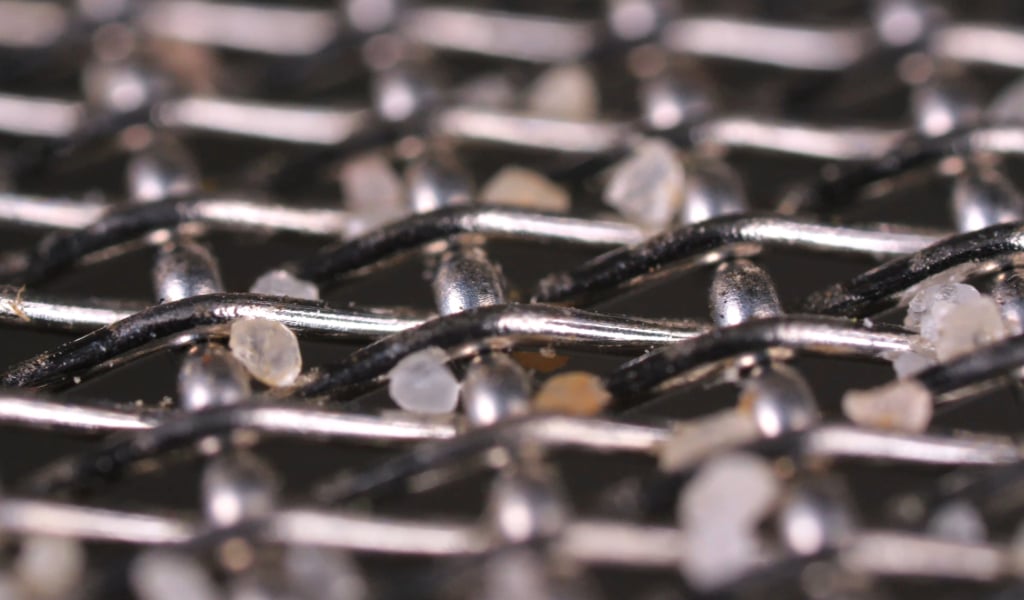The Role of Woven Wire Mesh in Reducing Fouling during Water Filtration
Fouling is one of the most disruptive issues in water filtration systems. Whether caused by biological growth, scaling, or particulate buildup, fouling leads to reduced flow rates, increased energy consumption, and frequent maintenance cycles. These inefficiencies not only drive up operational costs but also compromises the quality and reliability of the filtration process.
Woven wire mesh offers a highly effective solution to fouling by providing a precise and durable filtration medium. Its uniform pore structure and customizable specifications allow it to trap contaminants while maintaining consistent throughput. Unlike traditional filter media, woven wire mesh resists clogging and can be cleaned or replaced with minimal downtime.
At W.S. Tyler, our mission is to deliver cleaner, safer filtration solutions backed by over 150 years of engineering excellence. We understand the challenges fouling presents and are committed to helping industries overcome them with innovative mesh technologies that enhance performance and reliability.
In this article, we’ll explore the nature of fouling and its impact on water filtration systems, how woven wire mesh combats these issues, and how mesh design can balance filtration efficiency with fouling resistance. By the end, you’ll understand why woven wire mesh is a smart, long-term solution for maintaining clean and efficient water filtration.
What Is Fouling and Why It Disrupts Water Filtration
Fouling refers to the accumulation of the unwanted materials such as biological organisms, mineral scale, and suspended solids, on the surface or within the pores of filtration media. In water filtration systems, this buildup can occur gradually or rapidly depending on the water source and operating conditions.
Over time, fouling reduces the effectiveness of the filtration process and can lead to system failure if not properly managed. This issue is particularly severe in membrane-based technologies such as ultrafiltration and reverse osmosis, where fouling can cause irreversible damage to sensitive and costly membranes. Fouling mechanisms which include physical, organic, biofouling, and chemical scaling, can drastically reduce membrane efficiency and lifespan.
To mitigate these risks, effective pre-filtration such as microfiltration using woven wire mesh, is essential. It acts as a frontline defense, removing foulants before they reach the membrane stage, thereby enhancing system performance, reducing maintenance, and extending membrane life.
There are several types of fouling that affect water filtration systems. Biofouling involves the growth of microorganisms like bacteria and algae. Scaling results from the precipitation of dissolved minerals such as calcium carbonate.
Particulate fouling occurs when suspended solids accumulate on the filter surface. Each type presents unique challenges and requires specific mitigation strategies to maintain system performance.
When fouling occurs, it restricts flow rates and increases pressure drop across the filtration media. This forces systems to work harder, consuming more energy and requiring more frequent maintenance. In severe cases, fouling can lead to complete blockage, forcing costly shutdowns and replacements.
These disruptions not only affect operational efficiency but also compromise water quality and safety.
Understanding fouling is critical for designing and maintaining effective water filtration systems. By identifying the sources and behaviors of fouling, engineers and operators can implement targeted solutions that extend filter life and reduce downtime.
How Woven Wire Mesh Prevents Fouling
Woven wire mesh acts as a precise physical barrier that captures particles before they can accumulate and cause fouling. Its uniform pore structure allows for consistent filtration while minimizing the risk of clogging.
Unlike other filters, the open area of wire mesh enables contaminants to be trapped on the surface rather than embedded within the material, making it easier to clean and maintain.
The smooth surface of woven wire mesh reduces the likelihood of biological and particulate adhesion, making it especially effective in preventing biofouling. Microorganisms such as bacteria and algae are less likely to form colonies on mesh surfaces, particularly when constructed from stainless steel or other corrosion-resistant alloys.
In some cases, wire mesh can be enhanced with specialized metal coatings that support catalytic processes. These coatings can trigger reactions in aqueous solutions that generate free radicals, which actively destroy microorganisms and break down contaminants. It’s important to note that wire mesh can be adapted for advanced filtration roles in systems requiring enhanced microbial control and chemical reactivity.
One of the key advantages of woven wire mesh is its customizability. Mesh count, wire diameter, and weave types can all be tailored to suit specific filtration needs. This allows engineers to design systems that balance flow rate and particle retention, optimizing performance while minimizing fouling. Whether filtering fine sediments or larger particulates, mesh can be engineered to meet the exact demands of the application.
Unlike disposable filter media such as filter cartridges, woven wire mesh can be cleaned and reused multiple times without significant degradation. This not only reduces waste but also lowers long-term operational costs. Cleaning methods such as backwashing, ultrasonic baths, and even automatic self-cleaning filters are effective in restoring mesh performance, making it a sustainable choice for fouling-prone environments.
Balancing Filtration Efficiency and Fouling Resistance
In water filtration, there’s often a tradeoff between achieving high filtration efficiency and minimizing fouling. Finer filtration typically means smaller pore sizes, which can trap more contaminants but also increase the risk of clogging.
On the other hand, larger openings may reduce fouling but allow more particles to pass through. Finding the right balance is essential for maintaining both water quality and system longevity.
Interested in learning more about how to get twice as much throughput even at small filter fineness? Read more about our RPD HIFLO:
Woven wire mesh offers a unique advantage in balancing these competing priorities. By adjusting mesh count, wire diameter, and weave type, engineers can fine-tune the filtration characteristics to meet specific performance goals.
The ability to customize mesh specifications allows operators to optimize filtration systems for their unique operating conditions. Factors such as flow rate, contaminant type, and system pressure all influence the ideal mesh configuration.
With the right design, woven wire mesh can deliver consistent filtration performance while resisting fouling, even in demanding environments like wastewater treatment or industrial process water.
Balancing efficiency and fouling resistance isn’t just about initial performance as much as it's about long-term reliability. A well-designed mesh system reduces the frequency of maintenance, lowers operational costs, and ensures stable water quality over time. This makes woven wire mesh a strategic investment for facilities looking to improve filtration outcomes without sacrificing durability or ease of use.
Why Woven Wire Mesh Is the Smart Choice for Filtration
Fouling remains one of the most persistent challenges in water filtration, leading to reduced efficiency, increased maintenance, and compromised water quality. Through this article, we’ve explored what fouling is, how it affects filtration systems, and how woven wire mesh provides a reliable solution to mitigate its impact.
By integrating woven wire mesh into your filtration system, you gain access to a filtration medium that is durable, customizable, and resistant to clogging. Its ability to balance filtration efficiency with fouling resistance makes it a smart investment for long-term operational success across a wide range of water treatment applications.
At W.S. Tyler, we are committed to delivering cleaner, safer filtration solutions backed by over 150 years of experience. Our woven wire mesh products are engineered to meet the evolving needs of modern filtration systems, helping you maintain performance and reliability in even the most demanding environments.
Looking to fully optimize your water filtration setup with woven wire mesh? Check out our article below:
About Dylan Polz
Dylan is a Content Writer with 2 years of experience in marketing and SEO. Passionate about learning and strengthening his writing skills, he is currently expanding his expertise in particle analysis and woven wire mesh technologies. With a strong belief in the power of information to drive positive change, his goal is to develop content that supports cleaner, safer solutions across all industries.



